Archibald Campbell Campbell (Douglas)
Archibald Campbell Archibald Campbell Campbell [formerly Douglas], first Baron
Blythswood of Blysthwood (1835–1908), politician and physicist, was born in
Florence on 22 February 1835, the eldest of the nine children of
Archibald Douglas
(1809–1868), laird of
Mains, and his wife,
Caroline Agnes, the daughter of Mungo Dick of Pitkerro. Campbell's
name at birth was Archibald Campbell Douglas. His father claimed
descent from the Scottish noble families of both Campbell and
Douglas and in 1838 he changed his name to Campbell on succeeding
his cousin, Archibald Campbell, as laird of
Blythswood,
Renfrewshire; his eldest son thus became Archibald Campbell
Campbell.
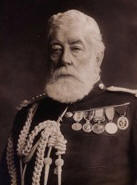
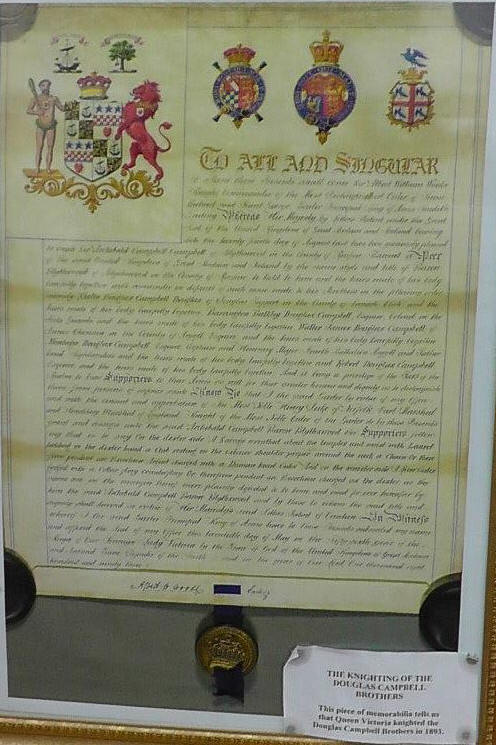
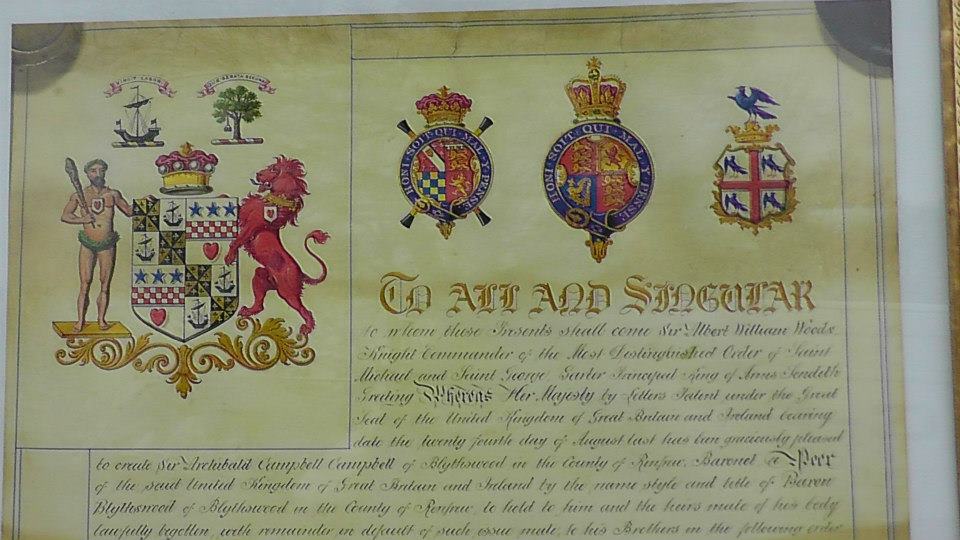
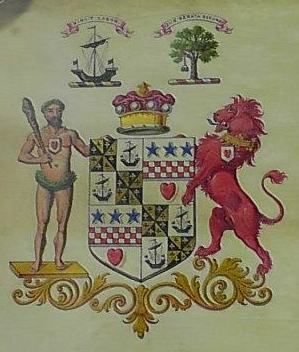
.jpg)

Campbell was educated privately for an army career.
At the age of sixteen he joined the 79th Highlanders, transferring
to the Scots Guards in the following year. He fought in the Crimea,
where he was badly wounded, and reached the rank of
lieutenant-colonel before retiring from the army on the death of his
father in 1868. While still in the army he married Augusta Clementina, the daughter of the wealthy Liberal peer Lord Carrington
(1796–1868), on 7 July 1864. Campbell assumed his patrimony as laird
of Blythswood, in the vicinity of Glasgow, in time to participate in
the general election of 1868, in which he stood as the unsuccessful
Conservative candidate for Paisley.
An enthusiast for
Conservative causes, especially tariff reform, Campbell and his
wife, Augusta,
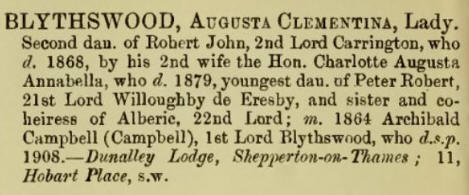 were both active in spreading the Conservative faith
in Scotland, participating in the foundation of the Conservative
Association and the Conservative Club in Glasgow, and in the
extension of the Primrose League in Scotland. He first entered
parliament after winning Renfrewshire in a by-election in 1873,
losing his seat in the general election the following year. He was
made a baronet in 1880, having failed to regain his seat in the
general election of that year. On the division of the county he
succeeded in being elected for West Renfrewshire in 1885 and
remained in the Commons until the defeat of the Conservatives in
1892, when he was raised to the peerage in Salisbury's resignation
honours list. were both active in spreading the Conservative faith
in Scotland, participating in the foundation of the Conservative
Association and the Conservative Club in Glasgow, and in the
extension of the Primrose League in Scotland. He first entered
parliament after winning Renfrewshire in a by-election in 1873,
losing his seat in the general election the following year. He was
made a baronet in 1880, having failed to regain his seat in the
general election of that year. On the division of the county he
succeeded in being elected for West Renfrewshire in 1885 and
remained in the Commons until the defeat of the Conservatives in
1892, when he was raised to the peerage in Salisbury's resignation
honours list.
Lord Blythswood was a notable amateur
scientist. Using his ample private resources he established an
extensive private laboratory at his home, Blythswood House, Renfrew.
In the conduct of his experiments he had the benefit of the detailed
advice and guidance of the professor of natural philosophy at
Glasgow, Lord Kelvin, who, as a leading Liberal Unionist in the west
of Scotland, was also a political ally. Between 1892 and 1905
Blythswood Laboratory, as it was known, was a location for
experiments into many areas at the frontier of physics including
cathode rays, X-rays, spectroscopy, and radioactivity. In 1900
Blythswood recruited a young physicist, Herbert Stanley Allen
(1873–1954), to take control of his laboratory. After Allen left to
take up a teaching position in London in 1905, the laboratory was
frequently used for engineering experiments by a Whitworth Scholar,
Walter Scoble.
Blythswood's forte was the construction of
large machines. The most notable of these was a Wimshurst electrical
machine with 128 plates, about ten times the size of the larger
models available on the market. In 1896, a few months after
Röntgen's discovery of X-rays was announced, Blythswood claimed that
with this machine he had managed to produce X-ray photographs
without passing the electricity through a partial vacuum, a quite
remarkable result. The credibility of his claim was aided by the
cautious support of Lord Kelvin. Another important Blythswood
machine was a sophisticated dividing engine for ruling diffraction
gratings. He worked on the perfection of this for many years; it was
later inherited by the National Physical Laboratory. In the last few
years of his life Blythswood was much occupied with aerodynamics;
‘his kites were a subject of wonder and awe to the rural population
of Renfrewshire’ (The Times) and his laboratory was used to conduct
experiments into the efficiency of aerial propellers.
Blythswood's political style was described as ‘bluff and
uncompromising’ (The Times). He commanded the Renfrewshire militia
from 1874 and was appointed aide-de-camp to Queen Victoria on
retiring this command in 1894. The queen had stayed at Blythswood
House during her official visit to Glasgow in 1888. His main
recreation, other than science, was angling. Elected president of
the Philosophical Society of Glasgow for 1898–1901, he rarely
attended their meetings but his ‘agency and influence’ (Minutes,
320) gained for them the right to call themselves the Royal
Philosophical Society of Glasgow.
Lord Blythswood (Archibald Campbell Douglas 1835-1908) built the
last church to be situated at Inchinnan (All Hallows) before it was
demolished for Glasgow Airport.
Blythswood was elected FRS
the year before his death. He died of heart failure at Blythswood
House on 8 July 1908, and was buried at Inchinnan, near Glasgow, on
11 July. He left no children. He was survived by his wife, and was
succeeded to the peerage by his brother, the
Revd Sholto Douglas
Campbell Douglas. The first baron, who served in Westminster's
Houses of Parliament in the Commons as an MP and later as with
subsequent generations in the Lords acquired the old manor house of Halliford in Shepperton
which is where in the year of his death he has a large tablet
monument in the church chancel by the Thames.
The last Lord Blythswood, the seventh baron, died
in 1940 at the age of twenty-one, while serving in the Scots Guards.
Notes:may be some confusion between this entry and that of
Brigadier General Archibald Campbell
Douglas
Any contributions will be
gratefully accepted
Errors and Omissions
|
|
The Forum
|
|
What's new?
|
|
We are looking for your help to improve the accuracy of The Douglas
Archives.
If you spot errors, or omissions, then
please do let us know
Contributions
Many articles are stubs which would benefit from re-writing.
Can you help?
Copyright
You are not authorized to add this page or any images from this page
to Ancestry.com (or its subsidiaries) or other fee-paying sites
without our express permission and then, if given, only by including
our copyright and a URL link to the web site.
|
|
If you have met a brick wall
with your research, then posting a notice in the Douglas Archives
Forum may be the answer. Or, it may help you find the answer!
You may also be able to help others answer their queries.
Visit the
Douglas Archives Forum.
2 Minute Survey
To provide feedback on the website, please take a couple of
minutes to complete our
survey.
|
|
We try to keep everyone up to date with new entries, via our
What's New section on the
home page.
We also use
the Community
Network to keep researchers abreast of developments in the
Douglas Archives.
Help with costs
Maintaining the three sections of the site has its costs. Any
contribution the defray them is very welcome
Donate
Newsletter
If you would like to receive a very occasional newsletter -
Sign up!
Temporarily withdrawn.
|
|
|
|
|
|
|
|
|


